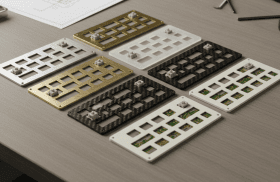As you dive deeper into the world of mechanical keyboards, you quickly realize the rabbit hole doesn’t stop at switches and keycaps. One of the biggest factors shaping how your keyboard feels and sounds is often hiding just under the surface: the plate.
Whether you’re after a soft, bouncy typing experience or something rock-solid with a satisfying “clack,” the plate material makes a huge difference. This guide lifts the lid on the most common plate materials, compares how they stack up, and ultimately helps you pick the right one for your setup.
Keyboard Plate Materials
There’s a huge range of different materials used for keyboard plates, each with their own feel, sound, and personality. Let’s take a look at the most common materials you’ll come across and what they mean for your new keyboard.
Polypropylene (PP)
![[MK]Draft: Guide to mechanical keyboard plate materials](https://www.market.com/wp-content/uploads/2025/10/-mk-draft-guide-to-mechanical-keyboard-plate-materials-1.png)
Image Credit: berserkeys.com.au
This is one of the most flexible plate options. A form of plastic, typing on PP is soft and forgiving, with a slightly muted sound profile that keeps things on the quieter side. It’s great if you love comfort and don’t mind some extra flex in your board, though it’s not the most responsive or durable over time.
Polycarbonate (PC)
![[MK]Draft: Guide to mechanical keyboard plate materials](https://www.market.com/wp-content/uploads/2025/10/-mk-draft-guide-to-mechanical-keyboard-plate-materials-2.png)
Image Credit: stackskb.com
A step firmer than PP, polycarbonate still offers plenty of flex but adds a brighter, poppier tone. They’re popular in custom builds for people chasing a fun sound and translucent look (though solid colors exist, too). Like PP, it’s lightweight and affordable but not as tough as metal plates.
Polyoxymethylene (POM)
![[MK]Draft: Guide to mechanical keyboard plate materials](https://www.market.com/wp-content/uploads/2025/10/-mk-draft-guide-to-mechanical-keyboard-plate-materials-3.png)
Image credit: upgradekeyboards.com
Think of POM as the middle ground between plastics to metals. It offers a soft, smooth typing feel but has a slightly deeper, more “thocky” sound compared to PP or PC. It’s ideal if you want comfort and flex without the hollow resonance sometimes found in other plastic plates.
FR4 (Flame Retardant-4)
![[MK]Draft: Guide to mechanical keyboard plate materials](https://www.market.com/wp-content/uploads/2025/10/-mk-draft-guide-to-mechanical-keyboard-plate-materials-4.png)
Image Credit: berserkeys.com.au
Best known for printed circuit boards, FR4 makes a great plate material thanks to its balanced characteristics. It’s semi-rigid, producing a deeper, less plasticky sound with a medium typing feel that’s neither too stiff nor too soft. FR4 is a solid, all-round pick for builders chasing versatility.
Aluminum
![[MK]Draft: Guide to mechanical keyboard plate materials](https://www.market.com/wp-content/uploads/2025/10/-mk-draft-guide-to-mechanical-keyboard-plate-materials-5.png)
Image Credit: thepihut.com
The classic all-rounder. Aluminum mechanical keyboard plates are firm but not overly stiff. The result is more of a clean “clack” that’s sharper than plastics but not as aggressive as harder options like brass or steel. They’re durable, lightweight, and widely available, making them a go-to for many brands and custom builders.
Brass
![[MK]Draft: Guide to mechanical keyboard plate materials](https://www.market.com/wp-content/uploads/2025/10/-mk-draft-guide-to-mechanical-keyboard-plate-materials-6.png)
Image Credit: sentraq.com
If you’re looking for added weight, stiffness, and a bold sound, brass delivers. Typing on a brass plate feels rock solid and gives a bright, resonant tone that stands out in any build. Brass looks beautiful in premium setups, but it’s heavier and more expensive than aluminum. However, not everyone loves the stiffness for daily comfort and extended use.
Carbon Fiber
![[MK]Draft: Guide to mechanical keyboard plate materials](https://www.market.com/wp-content/uploads/2025/10/-mk-draft-guide-to-mechanical-keyboard-plate-materials-7.png)
Image Credit: keebcats.co.uk
The same characteristics that make it great for vehicles, carbon fiber is a lightweight yet rigid option for your keyboard plate. Carbon fiber gives a firm typing feel with a relatively muted sound compared to metals. It’s an excellent option for people who want performance without too much heft, though it tends to be pricier.
Copper
![[MK]Draft: Guide to mechanical keyboard plate materials](https://www.market.com/wp-content/uploads/2025/10/-mk-draft-guide-to-mechanical-keyboard-plate-materials-8.png)
Image Credit: Reddit
Similar to brass in stiffness and weight, but with a slightly warmer tone. It’s a showpiece material that stands out for aesthetics as much as feel. Copper plates can develop a patina over time, adding character and a slightly grungier, industrial look as the metal oxidizes. Some people love this, others prefer a clean polish.
Steel
![[MK]Draft: Guide to mechanical keyboard plate materials](https://www.market.com/wp-content/uploads/2025/10/-mk-draft-guide-to-mechanical-keyboard-plate-materials-9.png)
Image Credit: u-buy.co.uk
The heaviest and stiffest of the common plate materials. Typing on steel is expectedly firm with little to no flex. This results in a sound that’s loud, sharp, and resonant “clank” that commands attention. It’s extremely durable, but unless you’re chasing maximum rigidity, it will likely feel a bit overkill for most people and everyday typing.
Keyboard Plate Materials: Comparison
Choosing the Right Plate Material
There may seem like loads to consider when choosing your plate material so let’s try to help narrow things down into a few smaller groupings.
If comfort is your top priority, plastics like PP, PC, or POM are your best bet. They add bounce and cushion your fingers during long typing or gaming sessions.
Want something versatile and more neutral? FR4 and aluminum are the safest all-round choices, offering balance without extremes at either end of the spectrum.
For builders chasing sound, brass and copper deliver bright, ringing tones that really stand out, while POM or FR4 will give you deeper, more subdued acoustics.
If durability is the main goal, metals (especially steel) win every time, though at the cost of comfort.
If you want aesthetics to shine, copper or brass plates are the best options. They will make your build look as premium as it feels.


